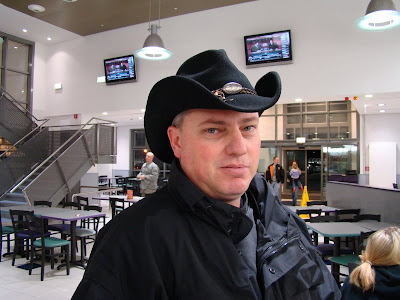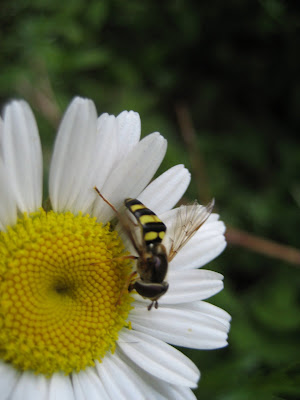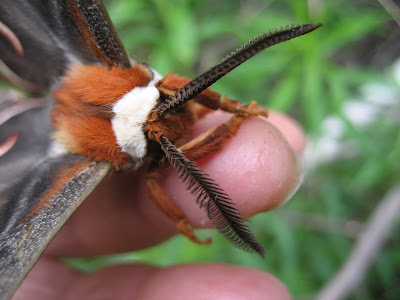Over the past year, I've gotten lots of good information about the nuts and bolts of top bar hive beekeeping and natural beekeeping practices from Gary Piantanida's excellent Hirschbach Apiary website. Gary's been a patient and generous online mentor, as well—so it's a pleasure to feature him in this, our second installment of Beek-Speak, a series of interviews with individuals who practice environmentally sound beekeeping.

Gerry Gomez Pearlberg: Tell us about yourself—including how and when you got started in beekeeping.
Gary Piantanida: I am a 44-year-old on active duty in the U.S. Army stationed in Vilseck, Germany. I have lived here in southern Germany (Bavaria) for the last 11 years and will soon retire here.
I assisted my grandfather with his Langstroth hives as a child in Peoria, Illinois. He kept all his hives facing out over the lake he would take me fishing on. Eventually we moved to New Jersey and I never went back to beekeeping—I was more interested in motorcycles.
I grew up the oldest of four, working in my Dad’s construction company operating heavy equipment. In the late 80’s, early 90’s, construction dropped off and we scaled back the company; I saw my opportunity to finally get out on my own, so I enlisted. Seven years later I found my wife and best friend here and decided to stay.
We have a house built into the side of a mountain; my back yard disappears into the forest. Thinking about my Grandpa shortly after he passed sparked the idea to set up some beehives; it had been so long I hit the Internet and found James Satterfield’s web site and was hooked. Here was a hive a guy who was handy with tools could build and it didn’t cost too much—so I built four and went out and bought 3 packages of bees!

 Gerry Gomez Pearlberg: Can you describe the environment/habitat in which you keep your bees?
Gerry Gomez Pearlberg: Can you describe the environment/habitat in which you keep your bees? Gary Piantanida: I keep my bees in a small town called Hirschbach (“Deer Creek”) 45 min. due east of Nurenburg. Our seasons are very similar to the northeast coast of the U.S.
We have two [nectar] flows here: the first starts in spring and ends beginning of June and is called blumen (flower) because the forage is primarily wildflower and fruit trees followed by the Wald (forest) fall flow wild flowers and nectar-producing bushes and trees.
The reason they distinguish between the two is because toward the end of June, all the fields are cut down and harvested into bails or rolls for winter feed for livestock—so the only place left [for the honeybees to forage] is the forest.
 Gerry Gomez Pearlberg: How has your beekeeping approach changed over time?
Gerry Gomez Pearlberg: How has your beekeeping approach changed over time?Gary Piantanida: In the last seven short years from research to today, I have to say my approach to beekeeping has changed 180 degrees. I was first shocked while reading George Imirie’s Pink Pages, I found a comment that said something to the effect of, "There are beekeepers, bee 'havers' and bee killers and anyone who does not feed syrup and medicate for a dozen different things is NOT a beekeeper." I don’t remember this well because I dismissed it—it clashed with my idea of beekeeping so much that I use it as an example of archaic thinking because it is that kind of thinking that got honeybees into the predicament they are in today.
 Gerry Gomez Pearlberg: On your website, you say, “To return to a natural state of harmony with the honeybee, Man must change his entire approach and abandon bee keeping altogether and adopt a practice of bee handling.” Please describe your beekeeping philosophy in more detail.
Gerry Gomez Pearlberg: On your website, you say, “To return to a natural state of harmony with the honeybee, Man must change his entire approach and abandon bee keeping altogether and adopt a practice of bee handling.” Please describe your beekeeping philosophy in more detail.Gary Piantanida: Sadly, George Imirie left out a category: bee handlers. I take the term from my days as a Military Police dog handler. If I could imprint this “philosophy” on all beek’s minds, it would go something like this: You can “keep” goldfish—for example—because YOU are providing EVERYTHING they need to survive; ignore them and they will perish; there is no interaction except, feed them and they eat. In other words, a goldfish is “kept” in the sense that you keep their whole environment within yours—totally dependent on you for survival….Therefore, you are “keeping” them like you keep a trophy on the mantel.
As dog handlers, we provide 90% of what the dogs need, but if mishandled, they let you know in ways that usually result in stitches. If a dog leaves, it has survival instincts and will fend for itself, but there is a high level of interaction between the handler and the dog.
It is the same with bees; if anyone has any doubts, go out and abuse a beehive and see what happens! We provide, at most, 10% of what the bees “like,” NOT NEED: a hive and maybe syrup. Bees have more survival instincts, as they are not domesticated and do not need us AT ALL.
In that respect, we don't "keep" bees at all—they come and go as they please and we pray that they stay and don’t get sick and that they make enough honey so we can have some. So who's depending on who? All we do that is "good" for the bees is to supply a container we hope they like as a house. Everything else we do to them goes against everything natural! Think about it. They do not need us at all to survive. If there were a disease that wiped out man tomorrow, your goldfish would eventually die, but bees would be fine—probably better off!
It is not the proper keeping of bees that allows us to take honey from a colony—it is the proper handling. The word “keeping” implies total ownership, period. With the word "handling" comes a certain implied respect for the creature being handled. This respect is the first step to restoring the honeybee to a state of sustainability. If you do not respect them—well, then, you are just a bee "keeper"!
 Gerry Gomez Pearlberg: I like your philosophy, and I especially appreciate your point about how the language we’re using to describe our relationship with the bees is symptomatic of the many problems we—and the bees—are experiencing today. That’s a good segue into top bar hives (TBH). Tell us about your experience with this form of bee-handling.
Gerry Gomez Pearlberg: I like your philosophy, and I especially appreciate your point about how the language we’re using to describe our relationship with the bees is symptomatic of the many problems we—and the bees—are experiencing today. That’s a good segue into top bar hives (TBH). Tell us about your experience with this form of bee-handling.Gary Piantanida: I first thought, “I will make the hives and throw the bees in and the rest will take care of itself.” It did just that, but not how I pictured it. I learned that bees will do whatever is best for survival, and if that means crossing four or five bars, so be it. I really do not like it when a hive gets cross-combed; I would go in and cut comb and push it straight and they would cross it up again and eventually they left for greener pastures. It was not the bees that were not on my sheet of music it was me who was not on theirs. I learned to listen to the bees and what they said was, “We will work with your comb guides”—so comb guides it is!
I went with TBH hives because they are as close to the natural thing as I can get. The Army has taken the better part of my back and I can no longer lift supers otherwise I would add Abbe Warre hives to my apiary. I also enjoy working with wood. even though I make a considerable pile for the fireplace now and then.
There is nothing more satisfying to me than building a hive and having bees actually use it—or finally getting a working dog to let go of the arm he is chewing on, on the first command! Working as one with nature, giving back to the environment as you take what you need. I love the fact that the top bar hive is a major player in the sustainability of such an important part of the food chain.
 Gerry Gomez Pearlberg: How do you deal with the Varroa mite?
Gerry Gomez Pearlberg: How do you deal with the Varroa mite?Gary Piantanida: When we speak of the Varroa mite, the first thing we should realize is that we are not going to eliminate it.
We must handle this parasite simultaneously [with handling our bees] so all can live in harmony. That harmony comes when the mite population does not overcome the bee population; a point commonly referred to as the “economic threshold.” You must manage the host/parasite balance below the economic threshold.
To do this requires daily monitoring of the natural mite fall, as this is a key indicator of the mite population. To do this, I use a sticky board and powdered sugar treatment only when necessary. [Ed Note: Powdered sugar is one option in the arsenal of relatively non-invasive, non-toxic treatments available for reducing the Varroa mite population in a colony to a level that can be managed by the bees. In short, sprinkling the bees with powdered sugar loosens the mites attached to the bees’ bodies, making it easier for the bees to remove and control the mites.]
I watch a new colony and record the daily mite fall; there will be a steady average and as the colony grows and moves toward fall, the mite population will increase—the sign that the mite population is starting to overcome the bee population. A rise in mite population can occur at anytime for a number of reasons (some still unknown). Will powdered sugar alone do the trick? NO—another contributing factor is the size of the cells that are in a natural nest.
A top bar hive (TBH) allows a colony to construct the comb in the nest however the colony sees fit. This is called a natural nest, just like a nest you would find in a hollow tree out in the forest, save for the vertical and horizontal positioning difference.
The Lusby’s came up with the small cell theory and found mites had a hard time reproducing in the smaller cells. You will have to research the theory if you are not familiar with it—it’s very extensive. Let’s just say it worked! Well, not exactly….If you took a natural nest out of a tree and measured the cells, you would find that there are smaller cells there—cells considerably smaller than the foundation being produced [by sellers of this product] today. OK, you say, Then it works….No, not if you keep measuring that natural nest: there are a variety of cell sizes according to what the colony needed!!!
 Meanwhile, back on the farm, bee supply companies are producing this small cell size onto foundation as fast as they can because they have found the silver bullet cure to the Varroa problem! Here we go again; have you ever heard the saying “History repeats itself”?
Meanwhile, back on the farm, bee supply companies are producing this small cell size onto foundation as fast as they can because they have found the silver bullet cure to the Varroa problem! Here we go again; have you ever heard the saying “History repeats itself”?In the early 1900’s, larger cell foundation was stamped out on mills with the idea that “If we make the bees build bigger cells, we will get bigger bees and more honey.” NOW we are making the same mistake on the other end of the spectrum! When does the madness end?
It ends here and now with the TBH: this hive and the natural nest contained within it, combined with regular monitoring of the daily mite fall supporting a treatment as necessary with sugar program is the cure. By “cure,” I do not mean the Varroa mite will be eliminated—I mean the mite will be handled at a level below the economic threshold. It is NO silver bullet, BUT we will still have a chance to undo about a century of damage due to greed.
Gerry Gomez Pearlberg: Let’s turn our attention to sweeter themes. Do you think the taste of honey has changed for you now that you know honeybees so well and are aware of how hard they work to make every drop of honey?
Gary Piantanida: Yes, the taste of honey for me has absolutely changed for me, because I understand the honeybee better having them here to study. But even more because the natural honey supply is threatened. If the honeybee disappears from the face of the earth, there won’t be anymore honey to taste—along with a number of other foods dependant on the honey bee as a pollinator.
 Gerry Gomez Pearlberg: What is your favorite beekeeping experience or story or adventure?
Gerry Gomez Pearlberg: What is your favorite beekeeping experience or story or adventure?Gary Piantanida: In my first season here in Germany, my in-laws were very excited to have bees and are very supportive. My father-in-law loved the beehives and always wanted to help.
The first hive to throw a swarm came as a surprise; it was about 20 feet up in a tree on a steep hillside. I rigged a plastic crate onto a pole and got suited up. Dad got a ladder and put it against the tree and as I started up I could see the swarm was not in a good position to be jamming a crate screwed to a pole under it. They had spread out wider than the top of the crate. No matter what I did I was not going to get them all on one shot.
Meanwhile, Dad is still holding the ladder in a tee shirt and shorts. I went down to try to tell him bees were going to fall right on him! Well he did not understand any English and back then my German was not that good. He just said “Ya ya,” and pointed up the ladder, so back up I went.
I aimed for the center and hit the branch as hard as I could. About a fist size ball of bees came down right on him! I could hear my wife laughing from the window. I could not look down I had lowered the crate and covered it with a screen and was balancing the whole contraption as I climbed back down. Dad was nowhere to be found; my wife said she never saw him run so fast!! He only got stung once on the arm and we still laugh about it today.
Gerry Gomez Pearlberg: What advice would you give to someone who is just beginning to keep bees?
Gary Piantanida: To the new beek, I say, Do not take the advice of a beek who lives in Florida if you live in Maine. Find a sustainable system that works for you, don’t get discouraged too easily and watch the bees. If you handle them right they will show you everything you need to know. If you want a leg up, join us at the International Top Bar Beekeeping Forum.
 **
**Below: An old military foot locker Gary re-purposed for hiving a swarm. A sweet example of RRR (Reduce, Reuse, Recycle) in action, no?


Gary's homemade feeder.
 A swarm moving into its new home.
A swarm moving into its new home.





































